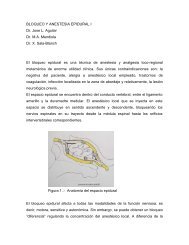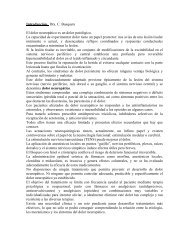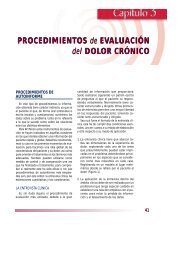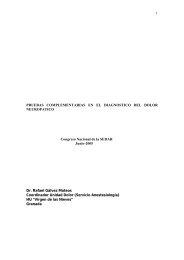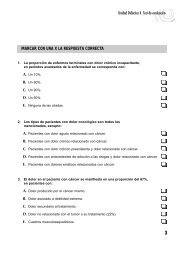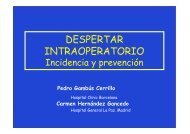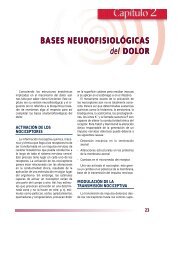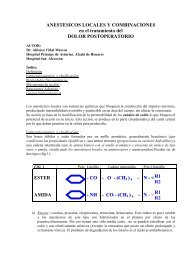Protection from aspiration with the LMA-ProSeal™ after vomiting: a ...
Protection from aspiration with the LMA-ProSeal™ after vomiting: a ...
Protection from aspiration with the LMA-ProSeal™ after vomiting: a ...
You also want an ePaper? Increase the reach of your titles
YUMPU automatically turns print PDFs into web optimized ePapers that Google loves.
78 CARDIOTHORACIC ANESTHESIA, RESPIRATION AND AIRWAY<strong>Protection</strong> <strong>from</strong> <strong>aspiration</strong> <strong>with</strong> <strong>the</strong> <strong>LMA</strong>-ProSeal<strong>after</strong> <strong>vomiting</strong>: a case report[La protection contre l’<strong>aspiration</strong> avec le ML-ProSeal après des vomissements :une étude de cas]David A. Mark MD FRCPCPurpose: To describe a case of <strong>vomiting</strong> <strong>with</strong> a laryngeal mask airwayProSeal (P<strong>LMA</strong>) in situ. The new design features of <strong>the</strong>P<strong>LMA</strong> and <strong>the</strong>ir role in protection <strong>from</strong> <strong>aspiration</strong> are discussed.Clinical features: A 27-yr-old female underwent bilateral reductionmammoplasty under general anes<strong>the</strong>sia utilizing a P<strong>LMA</strong> forairway management. During transfer to <strong>the</strong> postanes<strong>the</strong>sia careunit, she had an episode of active <strong>vomiting</strong> <strong>with</strong> <strong>the</strong> P<strong>LMA</strong> still insitu. The vomitus was expelled via <strong>the</strong> drain tube bypassing <strong>the</strong>pharynx entirely. Clinically, <strong>the</strong>re was no evidence of <strong>aspiration</strong> and<strong>the</strong> patient had an uneventful recovery.Conclusion: This case provides evidence that <strong>the</strong> drain tube of <strong>the</strong>P<strong>LMA</strong> directs vomitus away <strong>from</strong> <strong>the</strong> airway when properly positionedand may have prevented <strong>aspiration</strong> in an anes<strong>the</strong>tizedpatient.Objectif : Décrire un cas de vomissements en présence du masquelaryngé ProSeal (MLP) in situ. Les nouvelles particularités du MLP etleur rôle dans la protection contre l’<strong>aspiration</strong> sont discutés.Éléments cliniques : Une femme de 27 ans a subi une mammoplastiede réduction bilatérale sous anesthésie générale avec emploid’un MLP pour l’ouverture des voies aériennes. Pendant le transfert àla salle de réveil, elle a eu des vomissements et le MLP était toujoursen place. Les vomissement ont été évacués grâce à l’orifice dedrainage protégeant le pharynx. Il n’y a pas eu de signe évident d’<strong>aspiration</strong>et la patiente a connu une récupération sans incident.Conclusion : Ce cas apporte la preuve que le drain du MLP a permisde retirer les vomissements des vois aériennes quand il est bien misen place. Il peut empêcher l’<strong>aspiration</strong> chez un patient anesthésié.ASPIRATION of gastric contents is a seriousand potentially fatal complication ofanes<strong>the</strong>sia. There are numerous casereports of <strong>aspiration</strong> following regurgitationor <strong>vomiting</strong> <strong>with</strong> <strong>the</strong> laryngeal mask airway(<strong>LMA</strong>). 1–5 The new <strong>LMA</strong>-ProSeal (P<strong>LMA</strong>; TheLaryngeal Mask Company, Henley on Thames, UK)has been designed to decrease <strong>the</strong> risk of <strong>aspiration</strong>, 6however, only a single cadaveric study 7 addresses thisissue in <strong>the</strong> literature. I present a case of <strong>vomiting</strong> inan anes<strong>the</strong>tized patient <strong>with</strong> a P<strong>LMA</strong> in situ.Case reportA 27-yr-old, 84 kg female was scheduled for reductionmammoplasty. She had a negative personal and familyhistory for anes<strong>the</strong>tic problems. Review of systemsincluded irritable bowel syndrome and mild asthma,which were well controlled. She denied gastroesophagealreflux. Medications were salbutamol prnand depot medroxyprogesterone every three months.There were no known drug allergies.The patient had no solid food <strong>after</strong> midnight and lasthad clear fluids four hours preoperatively. She receivedoral naproxen 550 mg and acetaminophen 975 mg 90min preoperatively <strong>with</strong> sips of water. She underwentbilateral reduction mammoplasty under general anes<strong>the</strong>siautilizing a P<strong>LMA</strong> #4 for airway management.The P<strong>LMA</strong> was easily inserted and inflated <strong>with</strong> 30 mLof air. Gas leak <strong>from</strong> <strong>the</strong> drain tube was assessed accordingto <strong>the</strong> manufacturers instructions (<strong>LMA</strong>-ProSealinstruction manual): a small amount of gel was placedat <strong>the</strong> proximal end of <strong>the</strong> drain tube and observed forbubbles while manually ventilating through <strong>the</strong> P<strong>LMA</strong>.After ensuring an absence of gas leak <strong>from</strong> <strong>the</strong> drainFrom <strong>the</strong> Department of Anes<strong>the</strong>siology, Kingston General Hospital, Kingston, Ontario, Canada.Address correspondence to: Dr. David A. Mark, Department of Anes<strong>the</strong>siology, Kingston General Hospital, 76 Stuart Street, Kingston,Ontario K7L 2V7, Canada. Phone: 613-548-7827; Fax: 613-548-1375; E-mail: markd@kgh.kari.netAccepted for publication June 3, 2002.Revision accepted September 9, 2002.CAN J ANESTH 2003 / 50: 1 / pp 78–80
Mark: VOMITING AND THE <strong>LMA</strong>-PROSEAL 79tube at 30 cm H 2O pressure, <strong>the</strong> patient was ventilatedvia <strong>the</strong> P<strong>LMA</strong> <strong>with</strong> <strong>the</strong> following settings: tidal volume= 550 mL, respiratory rate = 10·min –1 <strong>with</strong> a resultantpeak inspired pressure of 10 cm H 2O. The surgery proceededuneventfully. After resuming spontaneous ventilation,<strong>the</strong> patient was transferred to <strong>the</strong> postanes<strong>the</strong>siacare unit (PACU) in <strong>the</strong> lateral position breathing roomair through <strong>the</strong> P<strong>LMA</strong>. Her O 2saturation (SpO 2) was97% upon leaving <strong>the</strong> operating room. As <strong>the</strong> patientreached <strong>the</strong> PACU, she vomited copious amounts ofbile stained fluid through <strong>the</strong> drain tube of <strong>the</strong> P<strong>LMA</strong>forcefully enough to splatter <strong>the</strong> PACU doors. She didn’tcough ei<strong>the</strong>r before or <strong>after</strong> <strong>vomiting</strong>. A pulseoximeter was immediately applied and measured anSpO 2of 95%. The oropharynx was suctioned for scantclear secretions but no bile stained fluid was obtained.After oral suctioning, <strong>the</strong> patient regained consciousnessand <strong>the</strong> P<strong>LMA</strong> was removed <strong>with</strong> <strong>the</strong> cuff inflated.Inspection of <strong>the</strong> surface of <strong>the</strong> P<strong>LMA</strong> over <strong>the</strong> glottis(and of <strong>the</strong> entire mask) revealed no evidence of bilestained fluid o<strong>the</strong>r than in <strong>the</strong> drain tube lumen and on<strong>the</strong> tip of <strong>the</strong> mask immediately surrounding this orifice.Initial vital signs in <strong>the</strong> PACU were: SpO 2= 95%on room air, heart rate = 85·min –1 , blood pressure =150/65 mmHg. Auscultation of <strong>the</strong> lungs revealedgood air entry bilaterally <strong>with</strong> no adventitial soundsheard. Her SpO 2remained 96–97% on room air. Theremainder of her stay was unremarkable and she wasdischarged home <strong>the</strong> next morning as planned.DiscussionThe <strong>aspiration</strong> of gastric contents is a rare but potentiallyserious adverse event in <strong>the</strong> perioperative period.Warner et al. 8 estimates an incidence of 11:10,000 foremergency surgery and 2.6:10,000 for electivesurgery <strong>with</strong> an overall mortality of 0.14 per 10,000.A meta-analysis by Brimacombe and Berry 9 estimated<strong>the</strong> incidence to be roughly 2:10,000 (5:24,562) <strong>with</strong>no reported cases of mortality when <strong>the</strong> <strong>LMA</strong> wasused as <strong>the</strong> primary form of airway management.Whe<strong>the</strong>r or not <strong>the</strong> <strong>LMA</strong> predisposes patients to <strong>aspiration</strong>is controversial. Some studies suggest itdoes 10,11 while o<strong>the</strong>rs suggest no effect. 12Two case reports 1,3 have suggested <strong>the</strong> <strong>LMA</strong> may“reflect” gastric contents into <strong>the</strong> trachea during <strong>vomiting</strong>.While Brain 13 has suggested that <strong>the</strong> <strong>LMA</strong> maylimit <strong>the</strong> amount of fluid aspirated by physically obliterating<strong>the</strong> pharynx, Nanji and Maltby 1 suggest <strong>the</strong>opposite in <strong>the</strong>ir case report of a near fatal pulmonary<strong>aspiration</strong>.While <strong>the</strong> design of <strong>the</strong> P<strong>LMA</strong> addresses this concernby providing a “drainage tube” or gastric lumento allow for escape of gastric contents, 6 publishedreports supporting or refuting its effectiveness in thisregard are scant. Keller et al. 7 showed that <strong>the</strong> P<strong>LMA</strong>(cuff inflated) allowed esophageal fluid to bypass <strong>the</strong>pharynx and mouth in a cadaver model. Agrò et al. 14described <strong>the</strong> successful use of a double lumen gastric<strong>LMA</strong> for upper gastrointestinal endoscopy in a patient<strong>with</strong> achalasia under general anes<strong>the</strong>sia. Brimacombedescribed a case where a prototype P<strong>LMA</strong> effectivelyshielded <strong>the</strong> glottis <strong>from</strong> gastric contents during anepisode of intraoperative regurgitation. 15 Evans et al. 16have reported a case where passive regurgitationthrough <strong>the</strong> drain tube occurred intraoperatively <strong>with</strong>no evidence of <strong>aspiration</strong>. In that case report, <strong>the</strong>P<strong>LMA</strong> was left in place and <strong>the</strong> procedure was completeduneventfully.The effects of <strong>vomiting</strong> in <strong>the</strong> presence of <strong>the</strong>P<strong>LMA</strong> remain unclear. In <strong>the</strong> present report, <strong>the</strong> gastriclumen of <strong>the</strong> P<strong>LMA</strong> directed vomitus away <strong>from</strong><strong>the</strong> airway <strong>with</strong> possible prevention of <strong>aspiration</strong> in ananes<strong>the</strong>tized patient. Brimacombe and Berry 9 suggeststhat <strong>aspiration</strong> is less likely <strong>with</strong> <strong>vomiting</strong> than regurgitationsince <strong>the</strong> glottis is closed. This argument cannotalone account for <strong>the</strong> absence of signs of<strong>aspiration</strong> in this patient since <strong>the</strong>re was no evidenceof bile stained fluid in <strong>the</strong> glottic bowl of <strong>the</strong> P<strong>LMA</strong>.Strategies to decrease <strong>the</strong> incidence of <strong>aspiration</strong>include an appropriate preoperative assessment for riskfactors, establishment of preoperative fasting guidelines,verification of patient compliance <strong>with</strong> <strong>the</strong>seguidelines and pharmacologic <strong>the</strong>rapies to decreasegastric volume and/or acidity. Although silent <strong>aspiration</strong>around cuffed endotracheal tubes (ETT) hasbeen well documented, 17,18 awake intubation or arapid sequence induction <strong>with</strong> a cuffed ETT remains<strong>the</strong> gold standard for patients at risk of <strong>aspiration</strong>requiring a general anes<strong>the</strong>tic. A gastric tube may beused to decrease <strong>the</strong> volume of gastric contents butdoes not guarantee complete emptying of <strong>the</strong> stomachand may interfere <strong>with</strong> gastroesophageal sphincterintegrity. 19 A gastric tube may also be insertedthrough <strong>the</strong> drain tube of <strong>the</strong> P<strong>LMA</strong> to facilitate emptyingof gastric contents. While this may help confirmcorrect positioning of <strong>the</strong> drain tube orifice of <strong>the</strong>P<strong>LMA</strong>, <strong>the</strong>se gastric tubes would have <strong>the</strong> same limitationsas those inserted <strong>with</strong>out <strong>the</strong> benefit of <strong>the</strong>P<strong>LMA</strong>. Unlike a gastric tube or ETT, <strong>the</strong> P<strong>LMA</strong>allowed gastric contents to completely bypass <strong>the</strong>pharynx during <strong>vomiting</strong> in this case. Susceptibility of<strong>the</strong> drain tube to blockage by solids remains to bedetermined and should be considered when selectinga P<strong>LMA</strong> for airway management. How this strategyfor decreasing risk of <strong>aspiration</strong> compares <strong>with</strong> acuffed ETT merits fur<strong>the</strong>r consideration.
80 CANADIAN JOURNAL OF ANESTHESIAAlthough <strong>aspiration</strong> remains a concern, <strong>the</strong> <strong>LMA</strong> hasproven itself to be an invaluable airway device. The newdesign features of <strong>the</strong> P<strong>LMA</strong> should decrease <strong>the</strong> risk of<strong>aspiration</strong>. This case demonstrates that in contrast tostandard ETT or gastric tubes, <strong>the</strong> P<strong>LMA</strong> may allowregurgitated or vomited gastric contents to completelybypass <strong>the</strong> pharynx when <strong>the</strong> drain tube is correctlypositioned to vent <strong>the</strong> esophagus. Whe<strong>the</strong>r this featureallows <strong>the</strong> P<strong>LMA</strong> to meet or even exceed <strong>the</strong> degree ofprotection <strong>from</strong> <strong>aspiration</strong> provided by cuffed ETTremains to be determined. As <strong>with</strong> any airway device,appropriate patient selection remains essential.References1 Nanji GM, Maltby JR. Vomiting and <strong>aspiration</strong> pneumonitis<strong>with</strong> <strong>the</strong> laryngeal mask airway. Can J Anaesth1992; 39: 69–70.2 Griffen RM, Hatcher IS. Aspiration pneumonia and <strong>the</strong>laryngeal mask airway. Anes<strong>the</strong>sia 1990; 45: 1039–40.3 Koehli N. Aspiration and <strong>the</strong> laryngeal mask airway(Letter). Anaes<strong>the</strong>sia 1991; 46: 419.4 Maroof M, Khan RM, Siddique MS. Intraoperative <strong>aspiration</strong>pneumonitis and <strong>the</strong> laryngeal mask airway(Letter). Anesth Analg 1993; 77: 409–10.5 Cyna AM, MacLeod DM. The laryngeal mask: cautionarytales (Letter). Anaes<strong>the</strong>sia 1990; 45: 167.6 Brain AIJ, Verghese C, Strube PJ. The <strong>LMA</strong> “ProSeal”–a laryngeal mask <strong>with</strong> an oesophageal vent. Br JAnaesth 2000; 84: 650–4.7 Keller C, Brimacombe J, Kleinsasser A, Loeckinger A.Does <strong>the</strong> ProSeal laryngeal mask airway prevent <strong>aspiration</strong>of regurgitated fluid? Anesth Analg 2000; 91:1017–20.8 Warner MA, Warner ME, Weber JG. Clinical significanceof pulmonary <strong>aspiration</strong> during <strong>the</strong> perioperativeperiod. Anes<strong>the</strong>siology 1993; 78: 56–62.9 Brimacombe JR, Berry A. The incidence of <strong>aspiration</strong>associated <strong>with</strong> <strong>the</strong> laryngeal mask airway: a metaanalysisof published literature. J Clin Anesth 1995; 7:297–305.10 Barker P, Langton JA, Murphy PJ, Rowbotham DJ.Regurgitation of gastric contents during general anaes<strong>the</strong>siausing <strong>the</strong> laryngeal mask airway. Br J Anaesth1992; 69: 314–5.11 Rabey PG, Murphy PJ, Langton JA, Barker P,Rowbotham DJ. Effect of <strong>the</strong> laryngeal mask airway onlower oesophageal sphincter pressure in patients duringgeneral anes<strong>the</strong>sia. Br J Anaesth 1992; 69: 346–8.12 Ho BYM, Skinner HJ, Mahajan RP. Gastrooesophagealreflux during day case gynaecologicallaparoscopy under positive pressure ventilation: laryngealmask vs. tracheal intubation. Anaes<strong>the</strong>sia 1998;53: 921–4.13 Brain AI. The laryngeal mask and <strong>the</strong> eosophagus(Letter). Anaes<strong>the</strong>sia 1991; 46: 701–2.14 Agro F, Brain A, Gabbrielli A, et al. Prevention of tracheal<strong>aspiration</strong> in a patient <strong>with</strong> a high risk of regurgitationusing a new double-lumen gastric laryngeal maskairway. Gastrointest Endosc 1997; 46: 257–8.15 Brimacombe J. Airway protection <strong>with</strong> <strong>the</strong> new laryngealmask prototype. Anaes<strong>the</strong>sia 1996; 51: 602–3.16 Evans NR, Llewellyn RL, Gardner SV, James MFM.Aspiration prevented by <strong>the</strong> ProSeal laryngeal maskairway: a case report. Can J Anesth 2002 49: 413–6.17 Bernhard WN, Cottrell JE, Sivakumaran C, Patel K,Yost L, Turndorf H. Adjustment of intracuff pressure toprevent <strong>aspiration</strong>. Anes<strong>the</strong>siology 1979; 50: 363–6.18 Petring OU, Adelhoj B, Jensen BN, Pedersen NO,Lomholt N. Prevention of silent <strong>aspiration</strong> due to leaksaround cuffs of endotracheal tubes. Anesth Analg1986; 65: 777–80.19 Priano LL. Trauma and burns. In: Barash PG, CullenBF, Stoelting RK (Eds.). Clinical Anes<strong>the</strong>sia, 2nd ed.Philadelphia: J.B. Lippincott Co.; 1992: 1417–29.



